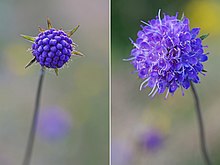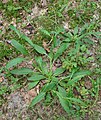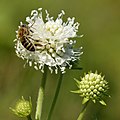Ordinary devil bite
| Ordinary devil bite | ||||||||||||
|---|---|---|---|---|---|---|---|---|---|---|---|---|

Common devil bite ( Succisa pratensis ) |
||||||||||||
| Systematics | ||||||||||||
|
||||||||||||
| Scientific name | ||||||||||||
| Succisa pratensis | ||||||||||||
| Monk |
The common devil's bite ( Succisa pratensis , syn .: Scabiosa succisa L.), also simply called Abbiss or Devil's Root and Devil's Bite , is a species of plant from the genus Succisa in the subfamily of the cardiac family (Dipsacoideae) within the honeysuckle family (Caprifoliaceae). The common name (eastern) devil's bite is also used for the related species Succisella inflexa .
The Hamburg Nature Conservation Foundation named the common devil's bite Flower of the Year 2015.
description
Vegetative characteristics
The devil bite grows as a perennial herbaceous plant and reaches heights of 30 to 50, rarely up to 80 centimeters. A vertically standing rhizome serves as a storage and persistence organ , which at the lower end mostly rots and therefore looks like it has been bitten off (hence the common name devil's bite); it extends up to 50 centimeters in depth. No runners are formed. The stem is smooth.
It has opposite elongated to oblong-lanceolate, mostly whole-edged leaves arranged in a rosette .
Generative characteristics
The flowering period extends from July to September. 50 to 80 flowers are in a hemispherical head-shaped inflorescence . The inflorescences unusually do not bloom from the bottom up, but from different zones. There are two rows of lanceolate bracts , the edge of which is finely ciliate. The bracts are shorter than the flower head. There are small chaff leaves on the bottom of the head . In contrast to widow flowers ( Knautia ) and scabiosa ( Scabiosa ), the flower head has no radiant marginal flowers.
The flowers are purple to blue. Below the individual flowers there is a square and coarse hairy outer calyx. At each edge it ends in a prickly pointed tip. The bowl-shaped inner chalice has five short-bristled black rays. The petals form a four-columnar 4–7 mm long, fused-leaf crown with a 3–4 mm long corolla tube. The free stamens clearly rise above the corolla tube. Two carpels are one under permanent, single-chamber ovary grown. There is only one ovule per ovary chamber . The extended stylus übergipfelt the stamens. The devil's bite offers nectar , but free access to it is denied by a layer of juice .
The 5 to 7 millimeter long fruits - square, shaggy achenes - are raised when the fruit ripe, around August, by the pressure of the chaff leaves. The calyx remains on the fruit.
The number of chromosomes is 2n = 20, less often 16 or 18.
ecology

The common devil bite is a gynodiac plant, which means that on the one hand plants with purely female flowers and on the other hand those with hermaphrodite flowers are formed. The stamens of the hermaphrodite flowers ripen before the stigmas . Cross- pollination should be promoted through this proterandry . The pollination is done by bees , butterflies and various Fly . The common devil bite is a mesomorphic hemicryptophyte .
Animals passing by and the movement of the wind spread the fruit. Plant species with this spreading strategy are called wind and animal spreaders. The fruits are on the one hand by ants , on the other hand by animals, to whose fur they attach themselves or are spread further by the wind .
The common devil bite serves various butterflies as nectar and their caterpillars as fodder plants. Depending on the ecotype, the caterpillars of the golden piebald moth feed oligophagous or monophagous, or the caterpillars of the pied pinto before they overwinter on the leaves of the plant. The gamma owl caterpillar uses the common devil's bite polyphagous . The nectar is particularly valued by endangered species such as the blue gentian ant , the brown-spotted mother-of-pearl butterfly , the swamphorn ram , the blood droplet , the sedge devil or the still relatively common great ox-eye .
Occurrence and endangerment
Succisa pratensis is widespread in North Africa and from Southwest, Central and Eastern to Southeastern Europe , Northern Europe and West Asia , the Caucasus and Siberia . There are sites in Portugal , Spain , France , Belgium , the Netherlands , the United Kingdom, Germany , Austria , Switzerland , Italy , Algeria , Tunisia , Russia , Georgia , Ciscaucasia, Iceland , Denmark , Norway , Sweden , Finland , the former Czechoslovakia , the former Yugoslavia , Hungary , Poland , the Ukraine , Albania , Bulgaria , Romania , Moldova , Greece and Turkey . It is also found in Algeria, Tunisia and Madeira. He is a neophyte in Canada and the United States .
The common devil's bite grows particularly in montane regions on poor moor meadows and prefers humid, humus soils . It is considered an indicator of leanness and colonizes suitable locations from the plains to the mountains. In the Black Forest and the Alps, it rises to altitudes of 1400 meters, for example on the Kackenköpf near Rohrmoos . He is a Molinietalia Trim in Central Europe characteristic species .
Growth sites in planar regions are tending to decline due to drainage measures. In some federal states, the devil's bite is on the red list of endangered species in endangerment category 3 (“endangered”).
Taxonomy

The first publication of Succisa pratensis took place in 1794 by Conrad Moench in Methodus. P. 489.
Image gallery
White blooming specimen with honeybees
Origin of name
The name devil bite denotes the special shape of its "rhizome" ( rhizome ); this gradually dies at the bottom and then looks like it has been bitten off. The generic name Succisa is derived from the Latin word succisus , which means "cut off at the bottom". Other names: mhd. Abbiz , lat. Morsus diaboli and herba sancti Petri .
Superstition
In folk medicine , devil bite is said to be effective against stone diseases (especially allegedly if the devil bite is picked in the night before June 24th).
The “rootstock” of the devil's bite, which looked like it had been bitten off, was ascribed an anti-demonic effect. Worn as an amulet around the neck, it should protect the wearer from evil sorcery. When hung in the barn, it was considered a safe means of protecting cattle from bewitching.
Use as an ornamental plant
The common devil's bite is occasionally planted as an ornamental plant in meadows and moor gardens that are moist and close to bog. It needs a moist location in a sunny location. Examples are the varieties 'Alba', which is characterized by a white crown, and the variety 'Nana' with a bluish-purple crown and a height of up to about 25 centimeters.
history
The common devil bite was mentioned as "abis" and "dufelbis" in south-west German manuscripts of the 15th century . The following healing applications were named there for the water burned from the roots: "Geswer" and "stab" in the body and especially around the heart, "versed" intestines and "run blood" in the body. The extreme tips of the herb, eaten on a May evening, should protect against the "frorer" (chills) for a year.
The Mainz Garden of Health from 1485 gave the following explanation for the naming of the plant (Chapter 261): The devil had "exercised so much violence" with this root that the Mother of God "had mercy on it" and removed the "violence" from the devil that he couldn't do with it afterwards. He bit off the root of the great "grim" that he then had, that he had escaped the "violence". So it's still growing today. Whoever carries the herb or the root cannot be harmed by the devil. The garden misleadingly named the late antique doctor Oreibasios as the informant .
Hieronymus Brunschwig took over the healing treatments given in the manuscripts of the 15th century in his Kleines Distillierbuch from 1500 and added an indication from his plague book: "Abiswasser is good to protect people and to protect against pestilence." the small distilling book were taken over from the fathers of botany .
By the middle of the 18th century at the latest, the devil's abbe was only mentioned in passing in medical books.
swell
- Latin Middle Ages: Ms. Germ. qu. 17, 1st quarter 15th century --- Cpg 226 1459–1469 --- Cpg 638 2nd quarter 15th century --- Cpg 575 1459 --- Garden of Health 1485 --- Hieronymus Brunschwig 1500
- Modern times: Otto Brunfels 1532 --- Hieronymus Bock 1539 --- Leonhart Fuchs 1543 --- Mattioli / Handsch / Camerarius 1586 --- Nicolas Lémery 1699/1721 --- Onomatologia medica completa 1755
Historical illustrations
Gart der Gesundheit 1485. Left: to the chapter Camphora. Right: to the chapter Morsus diaboli
Otto Brunfels 1532
Leonhart Fuchs 1543
Hieronymus Bock 1546
Mattioli / Handsch / Camerarius 1586
literature
- Gunter Steinbach (Ed.), Bruno P. Kremer u. a .: wildflowers. Recognize & determine. Mosaik, Munich 2001, ISBN 3-576-11456-4 .
- Manfred A. Fischer, Wolfgang Adler, Karl Oswald: Excursion flora for Austria, Liechtenstein and South Tyrol . 2nd, improved and enlarged edition. State of Upper Austria, Biology Center of the Upper Austrian State Museums, Linz 2005, ISBN 3-85474-140-5 .
- Oskar Sebald: Guide through nature. Wild plants of Central Europe . ADAC Verlag, Munich 1989, ISBN 3-87003-352-5 .
- Ruprecht Düll , Herfried Kutzelnigg : Pocket dictionary of plants in Germany. A botanical-ecological excursion companion to the most important species . 6th, completely revised edition. Quelle & Meyer, Wiebelsheim 2005, ISBN 3-494-01397-7 .
- Ruprecht Düll , Herfried Kutzelnigg : Pocket dictionary of plants in Germany and neighboring countries. The most common Central European species in portrait . 7th, corrected and enlarged edition. Quelle & Meyer, Wiebelsheim 2011, ISBN 978-3-494-01424-1 .
Individual evidence
- ↑ a b c d e f g h Succisa pratensis Moench, Ordinary devil bite. In: FloraWeb.de.
- ↑ Plant portrait Flower of the Year 2015 by Armin Jagel
- ↑ Detailed pictures from Bochum Botanical Association .
- ↑ a b Erich Oberdorfer : Plant-sociological excursion flora for Germany and neighboring areas . With the collaboration of Angelika Schwabe and Theo Müller. 8th, heavily revised and expanded edition. Eugen Ulmer, Stuttgart (Hohenheim) 2001, ISBN 3-8001-3131-5 , pp. 886 .
- ↑ a b c Succisa pratensis in the Germplasm Resources Information Network (GRIN), USDA , ARS , National Genetic Resources Program. National Germplasm Resources Laboratory, Beltsville, Maryland. Retrieved August 6, 2015.
- ↑ G. Domina (2017): Dipsacaceae. - In: Euro + Med Plantbase - the information resource for Euro-Mediterranean plant diversity. Datasheet Dipsacaceae.
- ↑ Erhard Dörr, Wolfgang Lippert : Flora of the Allgäu and its surroundings. Volume 2, IHW, Eching 2004, ISBN 3-930167-61-1 , p. 542.
- ↑ Manfred Boksch: The practical book of medicinal plants. BLV-Verlag, 2003, ISBN 3-405-14937-1 , p. 155.
- ↑ Eckehart J. Jäger, Friedrich Ebel, Peter Hanelt, Gerd K. Müller (eds.): Exkursionsflora von Deutschland . Founded by Werner Rothmaler. tape 5 : Herbaceous ornamental and useful plants . Springer, Spektrum Akademischer Verlag, Berlin / Heidelberg 2008, ISBN 978-3-8274-0918-8 , pp. 423 .
- ^ Gundolf Keil : Gart, Herbarius, Hortus. Notes on the oldest herbal book incunabula. In: Gelêrter der arzenîe, ouch apotêker. Commemorative publication Willem Frans Daems. (= Würzburg medical historical research. Volume 24). Pattensen 1982, ISBN 3-921456-35-5 , p. 602.
- ↑ Frankfurt a. M., University Library Ms. Germ. qu. 17 , Alsace, 1st quarter of the 15th century, sheet 340va (digitized) . Transcription: Abis water is well drunk for the heart and for all sick days of the heart and for the insulted distress and for running blood in the love One should eat the same crust on top of the spitzelin only spitzelin but is good on most of the evenings für den frorer dz ior… A krut dz is called abis the root is vndenan abe bitten The same roots are never vndetring [?] but you have vil [?] bad blood in dime libe dz distribute it and mus from each other and were you och lied do from . --- Sheet 342vb (digitized version ) : Dufelbis water is good for drinks and for stinging
- ↑ Cpg 226 , Alsace 1459–1469, sheet 102r (digitized version ) . Transcription: Abis or tuffels bit. water is well pressed that the likes are fallen or thrown / the jne the blood in the lib nit rynnet / vnd before Geswere in the lip and before the sting
- ↑ Cpg 638 , Alsace / Basel, 2nd quarter of the 15th century, sheet 25v (digitized version ) . Transcription: Item abebiz daz haisset tueffol picz vnd a haisset scabiosa dÿ water having all a burrow sÿ are good si are good for sting vnd gibberish vnd machant wide vmb dÿ prust vnd creative ser
- ↑ Cpg 575 Lake Constance (Constance?) 1459, sheet 47v (digitized version ) . Transcription: Tufel bis wasser ist gůt for geswer In the lib
- ↑ Gart der Gesundheit . (Mainz 1485). Edition Augsburg (Schönsperger) 1485, cap. 261 (digitized version)
- ↑ Hieronymus Brunschwig : Small distilling book . Strasbourg 1500, sheet 20v (digitized version )
- ^ Otto Brunfels : Contrafeyt Kreüterbuch. Strasbourg 1532, p. 91 (digitized version)
- ↑ Hieronymus Bock : New Kreütter book. Strasbourg 1539, book I, cap. 81 (digitized version)
- ^ Leonhart Fuchs : New Kreütterbuch. Strasbourg 1543, Cap. 272 (digitized version)
- ^ Pietro Andrea Mattioli : Commentarii, in libros sex Pedacii Dioscoridis Anazarbei, de medica materia. Translation by Georg Handsch, edited by Joachim Camerarius the Younger , Johan Feyerabend, Franckfurt am Mayn 1586, sheet 203v – 204r: Teuffels abbiß (digitized version )
- ↑ Nicolas Lémery . Dictionnaire universel des drogues simples. , Paris 1699, p. 748: Succisa (digitized version ) ; Translation. Complete material lexicon. Initially drafted in French, but now after the third edition, which has been enlarged by a large [...] edition, translated into high German / By Christoph Friedrich Richtern, [...]. Leipzig: Johann Friedrich Braun, 1721, Sp. 1090: Succisa (digitized version )
- ^ Albrecht von Haller (editor). Onomatologia medica completa or Medicinisches Lexicon which explains all names and artificial words which are peculiar to the science of medicine and pharmacists art clearly and completely [...]. Gaumische Handlung, Ulm / Frankfurt am Main / Leipzig 1755, p. 1027: Morsus diaboli (digitized version )
Web links
- Profile and distribution map for Bavaria . In: Botanical Information Hub of Bavaria .
- Ordinary devil bite . In: BiolFlor, the database of biological-ecological characteristics of the flora of Germany.
- Succisa pratensis Moench In: Info Flora , the national data and information center for Swiss flora . Retrieved April 1, 2016.
- Distribution in the northern hemisphere according to Eric Hultén .
- Thomas Meyer: Devil's bite data sheet with identification key and photos at Flora-de: Flora von Deutschland (old name of the website: Flowers in Swabia ).
- Data sheet with photo and distribution in France at Tela Botanica .
- Digital library Braunschweig .














